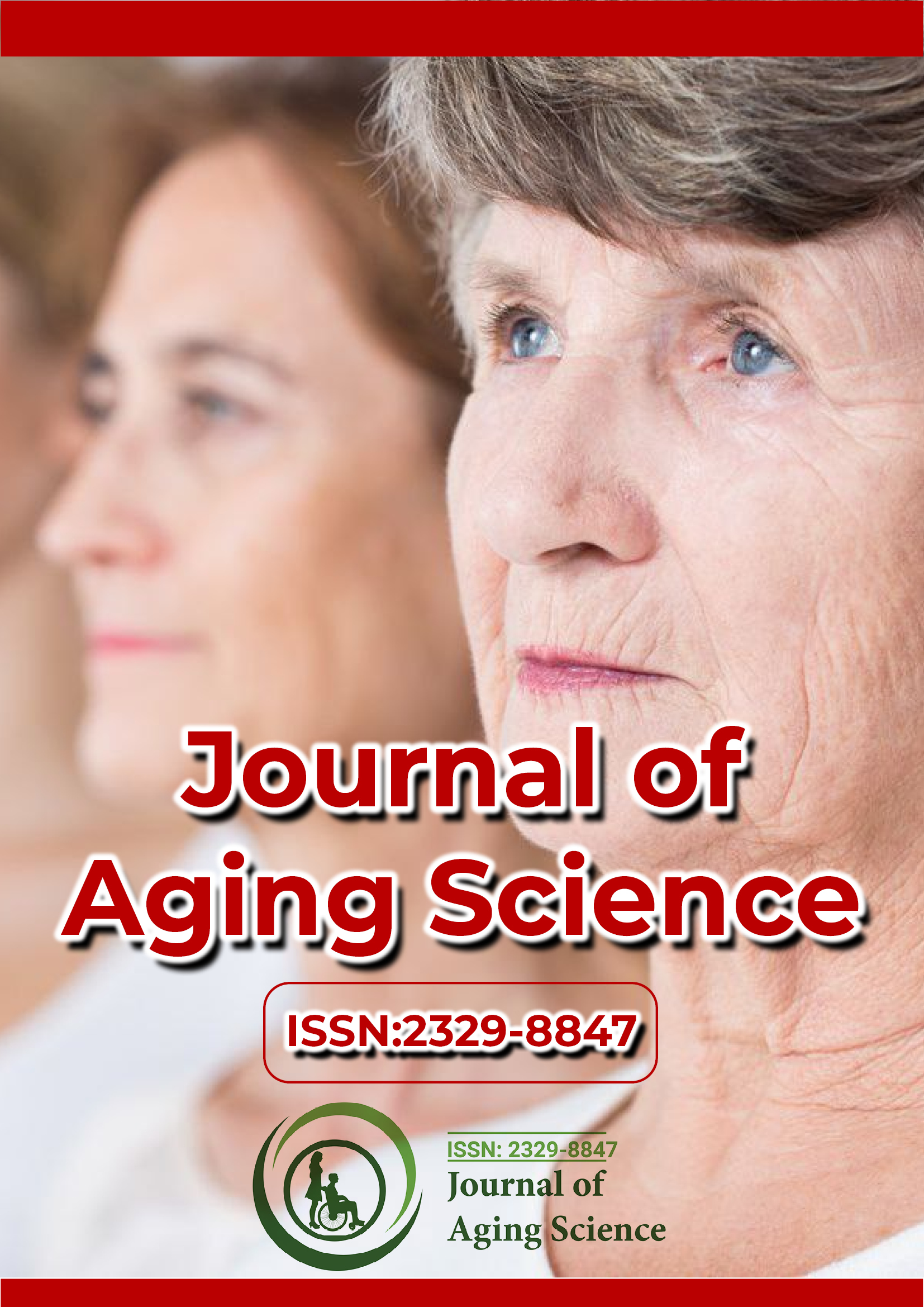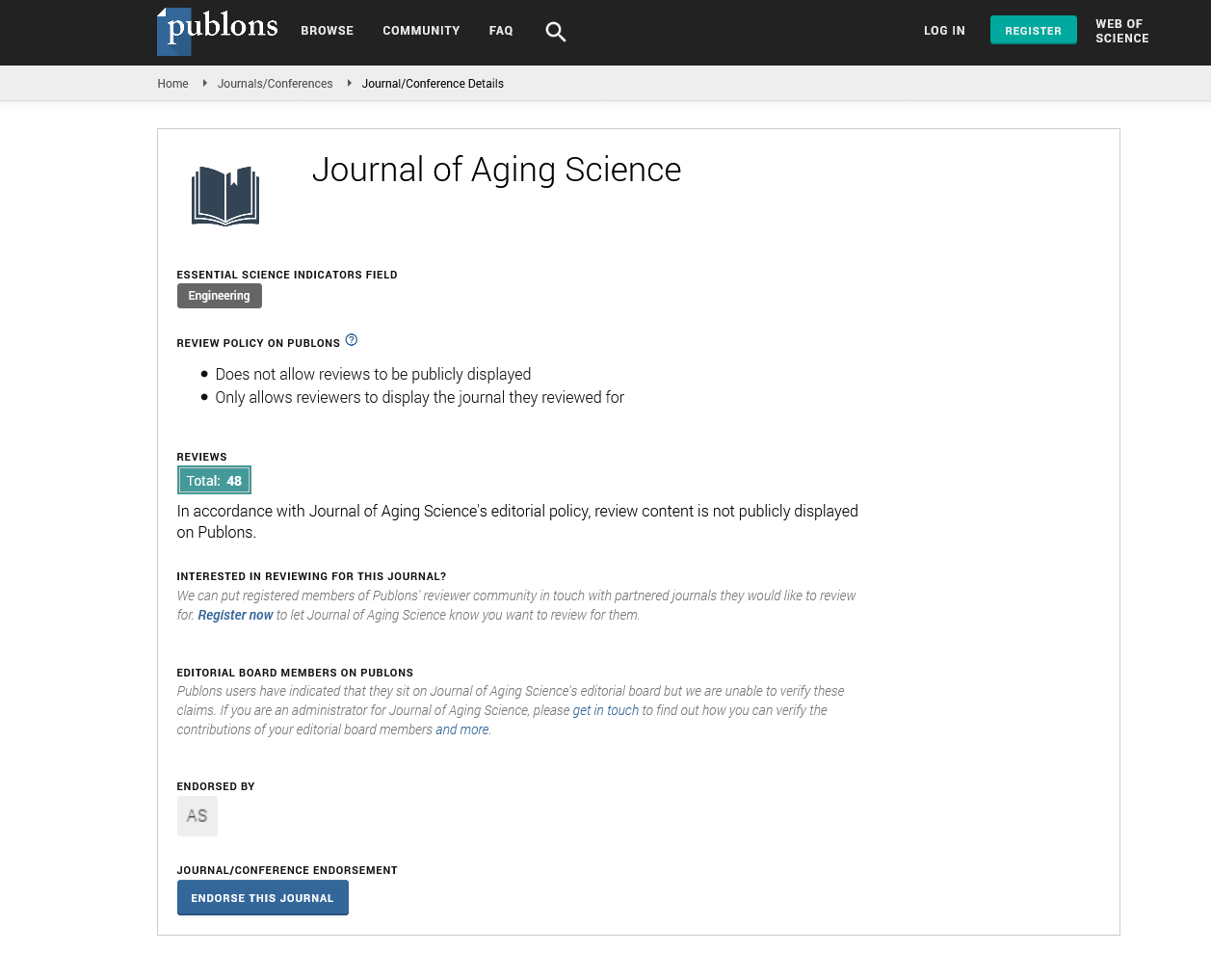Indexed In
- Open J Gate
- Academic Keys
- JournalTOCs
- ResearchBible
- RefSeek
- Hamdard University
- EBSCO A-Z
- OCLC- WorldCat
- Publons
- Geneva Foundation for Medical Education and Research
- Euro Pub
- Google Scholar
Useful Links
Share This Page
Journal Flyer

Open Access Journals
- Agri and Aquaculture
- Biochemistry
- Bioinformatics & Systems Biology
- Business & Management
- Chemistry
- Clinical Sciences
- Engineering
- Food & Nutrition
- General Science
- Genetics & Molecular Biology
- Immunology & Microbiology
- Medical Sciences
- Neuroscience & Psychology
- Nursing & Health Care
- Pharmaceutical Sciences
Short Communication - (2025) Volume 13, Issue 2
The Impact of Lipid Metabolism on Aging and Age-Related Disorders
Jason Morris*Received: 28-Mar-2025, Manuscript No. JASC-25-28630; Editor assigned: 31-Mar-2025, Pre QC No. JASC-25-28630 (PQ); Reviewed: 07-Apr-2025, QC No. JASC-25-28630; Revised: 14-Apr-2025, Manuscript No. JASC-25-28630 (R); Published: 28-Apr-2025, DOI: 10.35248/2329-8847.25.13.414
Description
Aging is a complex biological process influenced by genetic, environmental and metabolic factors. Among these, lipid metabolism plays a critical role in cellular function and homeostasis. Lipids are necessary macromolecules that contribute to membrane integrity, energy storage and cell signaling. Dysregulation of lipid metabolism is increasingly recognized as a key contributor to aging and the development of age-related disorders such as cardiovascular diseases, neurodegenerative conditions and metabolic syndromes. Understanding the exchange between lipid metabolism and aging can provide insights into potential therapeutic interventions to enhance longevity and mitigate age-related diseases.
Lipid metabolism and its role in aging
Lipid metabolism surrounds the synthesis, degradation and utilization of lipids in cells and tissues. Key lipids involved in these processes include triglycerides, phospholipids, cholesterol and sphingolipids. The balance of lipid metabolism is important for maintaining cellular homeostasis and its disruption can lead to oxidative stress, inflammation and mitochondrial dysfunction, all of which are attributes of aging [1,2].
As organisms age, lipid metabolism undergoes significant alterations. One of the primary changes observed in aging is an increase in lipid peroxidation, where Reactive Oxygen Species (ROS) cause oxidative damage to lipids. This leads to impaired membrane integrity and cellular dysfunction. Additionally, aging is associated with a decline in lipid turnover, resulting in lipid accumulation and ectopic fat deposition in non-adipose tissues such as the liver, heart and muscles. These changes contribute to metabolic dysregulation and the onset of various age-related disorders.
Lipid metabolism and age-related disorders
Cardiovascular diseases: Cardiovascular Diseases (CVDs) are among the leading causes of mortality in aging populations. Lipid metabolism plays a pivotal role in cardiovascular health, with imbalances in cholesterol and triglyceride levels contributing to atherosclerosis, hypertension and other cardiac conditions. Aging is often accompanied by elevated Low-Density Lipoprotein (LDL) cholesterol and reduced High-Density Lipoprotein (HDL) cholesterol, increasing the risk of plaque formation and vascular complications. Moreover, chronic inflammation driven by lipid dysregulation increases endothelial dysfunction, further accelerating cardiovascular aging [3,4].
Neurodegenerative disorders: The brain is highly dependent on lipid metabolism for maintaining synaptic function, neuronal integrity and myelination. Disruptions in lipid homeostasis have been implicated in neurodegenerative diseases such as Alzheimer’s Disease (AD) and Parkinson’s Disease (PD). For instance, altered cholesterol metabolism in the brain affects amyloid-beta processing, a key factor in AD pathology. Additionally, sphingolipid dysregulation contributes to neuroinflammation and cognitive decline. Lipid-based therapeutic strategies, such as omega-3 fatty acid supplementation and cholesterol-lowering agents, are being explored for their potential neuroprotective effects in aging individuals.
Metabolic disorders: Aging is closely associated with an increased prevalence of metabolic disorders such as obesity, type 2 diabetes and Non-Alcoholic Fatty Liver Disease (NAFLD). Insulin resistance, an attribute of metabolic aging, is linked to alterations in lipid metabolism, including increased circulating free fatty acids and ectopic lipid accumulation in insulinsensitive tissues [5]. These metabolic changes contribute to chronic inflammation and mitochondrial dysfunction, increasing age-related metabolic decline. Strategies targeting lipid metabolism, such as caloric restriction and pharmacological interventions, have shown potential in improving metabolic health and extending lifespan.
Inflammation and immune system dysfunction
Lipid metabolism is complexly linked to immune function, with certain lipid species acting as bioactive signaling molecules in inflammatory pathways. Aging is associated with a phenomenon known as “inflammaging,” characterized by chronic, low-grade inflammation that contributes to tissue damage and disease progression. Lipid-derived mediators, such as prostaglandins and leukotrienes, play a role in modulating immune responses and their dysregulation can lead to immune senescence. Dietary and pharmacological approaches targeting lipid-mediated inflammation hold potential for mitigating age-related immune dysfunction [6].
Potential interventions to modulate lipid metabolism in aging
Given the significant impact of lipid metabolism on aging and age-related disorders, various strategies have been proposed to modulate lipid homeostasis and promote healthy aging.
Dietary interventions: Nutritional approaches, such as the Mediterranean diet and ketogenic diet, have been shown to positively influence lipid metabolism. These diets emphasize healthy fats, such as monounsaturated and polyunsaturated fatty acids, which can improve lipid profiles and reduce inflammation [7,8]. Additionally, caloric restriction and intermittent fasting have been associated with enhanced lipid turnover, reduced oxidative stress and improved metabolic health in aging individuals.
Pharmacological interventions: Several pharmacological agents targeting lipid metabolism have been explored for their potential anti-aging effects. Statins, commonly used to lower cholesterol, have shown benefits beyond cardiovascular protection, including anti-inflammatory and neuroprotective properties [9,10]. Similarly, fibrates and omega-3 fatty acid supplements have been investigated for their role in modulating lipid profiles and reducing the risk of metabolic and neurodegenerative disorders.
Conclusion
Lipid metabolism is a fundamental aspect of aging, influencing cellular function, metabolic health and disease susceptibility. Dysregulation of lipid homeostasis is a common feature of aging and is implicated in a range of age-related disorders, including cardiovascular diseases, neurodegeneration and metabolic syndromes. Understanding the complex relationship between lipid metabolism and aging provides valuable insights into potential interventions aimed at promoting healthy aging.
References
- Johnson AA, Stolzing A. The role of lipid metabolism in aging, lifespan regulation, and ageâ?related disease. Aging cell. 2019;18(6):e13048.
[Crossref] [Google Scholar] [PubMed]
- Chung KW. Advances in understanding of the role of lipid metabolism in aging. Cells. 2021;10(4):880.
[Crossref] [Google Scholar] [PubMed]
- Zeng Q, Gong Y, Zhu N, Shi Y, Zhang C, Qin L. Lipids and lipid metabolism in cellular senescence: Emerging targets for age-related diseases. Ageing Res Rev. 2024:102294.
[Crossref] [Google Scholar] [PubMed]
- Li X, Wang J, Wang L, Gao Y, Feng G, Li G, et al. Lipid metabolism dysfunction induced by age-dependent DNA methylation accelerates aging. Signal Transduct Target Ther. 2022;7(1):162.
[Crossref] [Google Scholar] [PubMed]
- Amorim JA, Coppotelli G, Rolo AP, Palmeira CM, Ross JM, Sinclair DA. Mitochondrial and metabolic dysfunction in ageing and age-related diseases. Nat Rev Endocrinol. 2022;18(4):243-258.
[Crossref] [Google Scholar] [PubMed]
- Saher G. Cholesterol metabolism in aging and age-related disorders. Annu Rev Neurosci. 2023;46(1):59-78.
[Crossref] [Google Scholar] [PubMed]
- Song R, Hu M, Qin X, Qiu L, Wang P, Zhang X, et al. The roles of lipid metabolism in the pathogenesis of chronic diseases in the elderly. Nutrients. 2023;15(15):3433.
[Crossref] [Google Scholar] [PubMed]
- Fransen M, Nordgren M, Wang B, Apanasets O, Van Veldhoven PP. Aging, age-related diseases and peroxisomes. Subcell Biochem. 2013:45-65.
[Crossref] [Google Scholar] [PubMed]
- Jové M, Portero-Otín M, Naudí A, Ferrer I, Pamplona R. Metabolomics of human brain aging and age-related neurodegenerative diseases. J Neuropathol Exp Neurol. 2014;73(7):640-657.
[Crossref] [Google Scholar] [PubMed]
- Mutlu AS, Duffy J, Wang MC. Lipid metabolism and lipid signals in aging and longevity. Dev cell. 2021;56(10):1394-1407.
[Crossref] [Google Scholar] [PubMed]
Citation: Morris J (2025). The Impact of Lipid Metabolism on Aging and Age-Related Disorders. J Aging Sci. 13:414.
Copyright: © 2025 Morris J. This is an open-access article distributed under the terms of the Creative Commons Attribution License, which permits unrestricted use, distribution and reproduction in any medium, provided the original author and source are credited.

